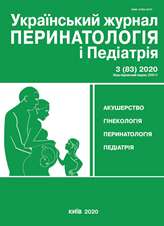Improving the quality of life in the postpartum period: reduce the incidence of hemorrhoids and its complications
DOI:
https://doi.org/10.15574/PP.2020.83.22Keywords:
hemorrhoids, pregnancy, postpartum period, causes, diagnosis, treatment, quality of lifeAbstract
There are insufficient data in the literature on the actual frequency and prevalence of hemorrhoids among the general population. The incidence of hemorrhoids during pregnancy and in the postpartum period, according to various authors, varies considerably: from a third of women to 86%. The frequency of thrombosis of external hemorrhoids and cracks of the anus in the postpartum period is 25–33%.
The aim is to analyze data on the frequency of hemorrhoids during pregnancy and within postpartum period, as well as data on the impact of perianal disorders on the quality of life of women; substantiate recommendations for improving the quality of life of such women.
Materials and methods. The analysis of databases from medical research PubMed, MedScape, NCBI by keywords: hemorrhoids, pregnancy, postpartum period, causes, diagnosis, treatment, quality of life. 2000 publications were found, of which, according to relevant information, 4 were selected for analysis. The selection criteria were: cohort of subjects (at least 200 people), prospectiveness of observation (pregnancy and postpartum period), availability of data on medical examination. The information-analytical method and content-analysis are used.
Results and conclusions. Hemorrhoids are a frequent complication during pregnancy and in the postpartum period. Perianal disease reduces the quality of life of women during pregnancy and in the postpartum period and requires improved care recommendations. Reparon Herbal, which contains herbal substances and sucralfate, according to the instructions, can be used during pregnancy and in the postpartum period to reduce the clinical manifestations of hemorrhoids, which will improve the quality of life of such women.
References
Abramowitz L, Sobhani I, Benifla JL, Vuagnat A, Daraї E, Mignon M et al. (2002). Anal fissure and thrombosed external hemorrhoids before and after delivery. Dis Colon Rectum. 45: 650-655. https://doi.org/10.1007/s10350-004-6262-5; PMid:12004215
Beksac K, Aydin E, Uzelpasacі E, Akbayrak T, Ozyuncu O. (2018). Hemorrhoids and related complications in primigravid pregnancy. Journal of Coloproctology (Rio de Janeiro). 38 (3): 179-182. https://doi.org/10.1016/j.jcol.2018.03.002
Drossman DA. (2016, Feb 19). Functional gastrointestinal disorders: history, pathophysiology, clinical features and Rome IV. Gastroenterology: S0016-5085(16)00223-7. doi: 10.1053/j.gastro.2016.02.032. https://doi.org/10.1053/j.gastro.2016.02.032; PMid:27144617
Hollingshead JR, Phillips RK. (2016). Haemorrhoids: modern diagnosis and treatment. Postgrad Med J. 92: 4-8. https://doi.org/10.1136/postgradmedj-2015-133328; PMid:26561592
Kubicsek T, Kazy Z, Czeizel AE. (2011). Teratogenic potential of tribenoside, a drug for the treatment of haemorrhoids and varicose veins - a population-based case-control study. Reprod Toxicol. 31: 464-469. https://doi.org/10.1016/j.reprotox.2010.12.001; PMid:21182931
Kukla L, Bouchalova M, Shkiriak-Nyzhnyk Z, Chyslovska N, Golding J, Goodfellow S et al. (2008). Chronic morbidity in women, namely in pregnancy. Comparative study between West, Central and East European centres. Lik Sprava. 1-2: 43-60.
Lohsiriwat V. (2015). Treatment of hemorrhoids: A coloproctologist's view. World journal of gastroenterology. 21 (31): 9245-9252. https://doi.org/10.3748/wjg.v21.i31.9245; PMid:26309351 PMCid:PMC4541377
Lorenc Z, Gokce O. (2016). Tribenoside and lidocaine in the local treatment of hemorrhoids: an overview of clinical evidence. Eur Rev Med Pharmacol Sci. 20: 2742-2751.
Martіnez-Galiano JM, Hernandez-Martinez A, Rodriguez-Almagro J, Delgado-Rodriguez M, Rubio-Alvarez A, Gomez-Salgado J. (2019). Women's Quality of Life at 6 Weeks Postpartum: Influence of the Discomfort Present in the Puerperium. Int J Environ Res Public Health. 16 (2): 253. https://doi.org/10.3390/ijerph16020253; PMid:30658406 PMCid:PMC6351916
Poskus T, Buzinskiene D, Drasutiene G, Samalavicius NE, Barkus A, Barisauskiene A et al. (2014). Haemorrhoids and anal fissures during pregnancy and after childbirth: a prospective cohort study. BJOG. 121: 1666-1671. https://doi.org/10.1111/1471-0528.12838; PMid:24810254
Rungsiprakarn P, Laopaiboon M, Sangkomkamhang US, Lumbiganon P, Pratt JJ. (2015). Interventions for treating constipation in pregnancy. Cochrane Database Syst Rev: 9. https://doi.org/10.1002/14651858.CD011448.pub2; PMid:26342714
Rungsiprakarn P, Laopaiboon M, Sangkomkamhang US, Lumbiganon P, Pratt JJ. (2015, Sep 4). Interventions for treating constipation in pregnancy. Cochrane Database Syst Rev. (9): CD011448. https://doi.org/10.1002/14651858.CD011448.pub2 ;PMid:26342714
Shi W, Xu X, Zhang Y, Guo S, Wang J. (2015). Epidemiology and risk factors of functional constipation in pregnant women. Plos One: 10. https://doi.org/10.1371/journal.pone.0133521; PMid:26208169 PMCid:PMC4514689
Turawa EB, Musekiwa A, Rohwer AC. (2014, Sep 23). Interventions for treating postpartum constipation. Cochrane Database Syst Rev. (9): CD010273. https://doi.org/10.1002/14651858.CD010273.pub2; PMid:25246307
Downloads
Published
Issue
Section
License
The policy of the Journal “Ukrainian Journal of Perinatology and Pediatrics” is compatible with the vast majority of funders' of open access and self-archiving policies. The journal provides immediate open access route being convinced that everyone – not only scientists - can benefit from research results, and publishes articles exclusively under open access distribution, with a Creative Commons Attribution-Noncommercial 4.0 international license(СС BY-NC).
Authors transfer the copyright to the Journal “MODERN PEDIATRICS. UKRAINE” when the manuscript is accepted for publication. Authors declare that this manuscript has not been published nor is under simultaneous consideration for publication elsewhere. After publication, the articles become freely available on-line to the public.
Readers have the right to use, distribute, and reproduce articles in any medium, provided the articles and the journal are properly cited.
The use of published materials for commercial purposes is strongly prohibited.

